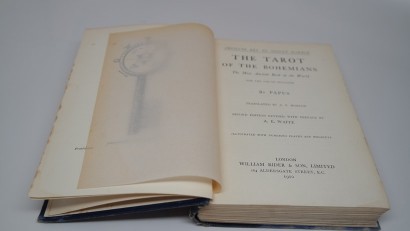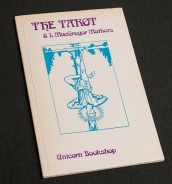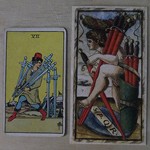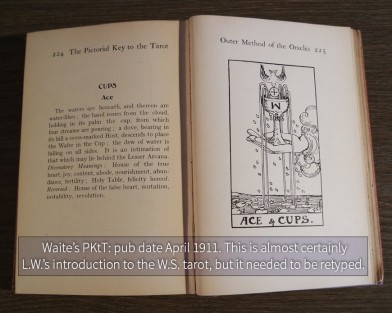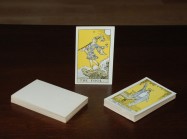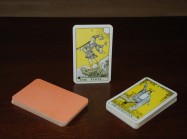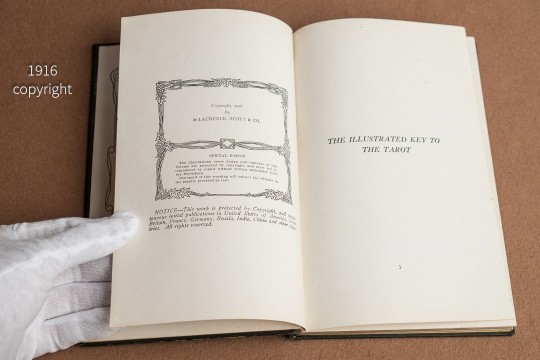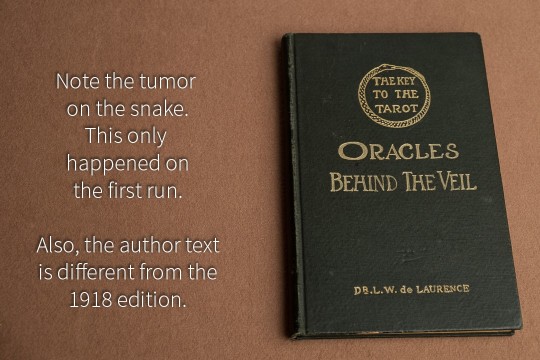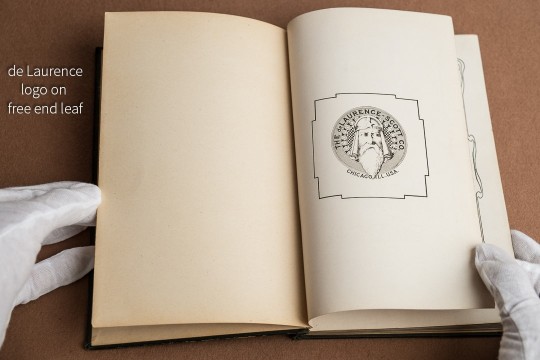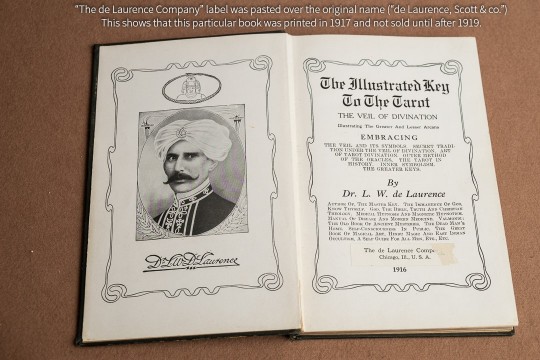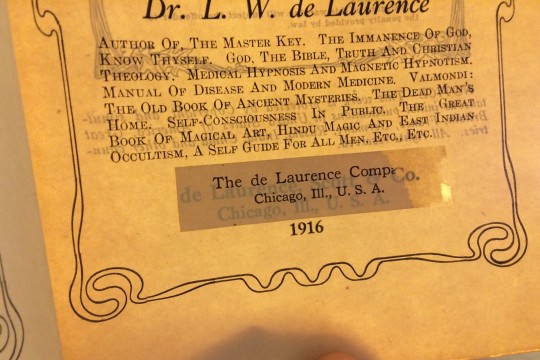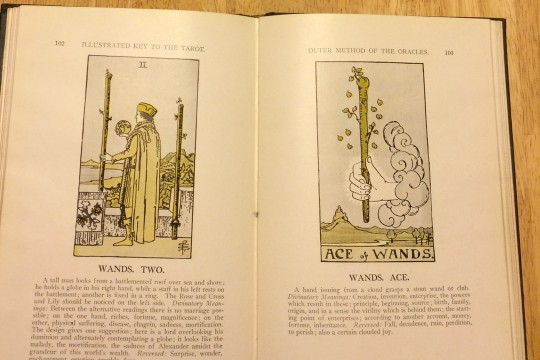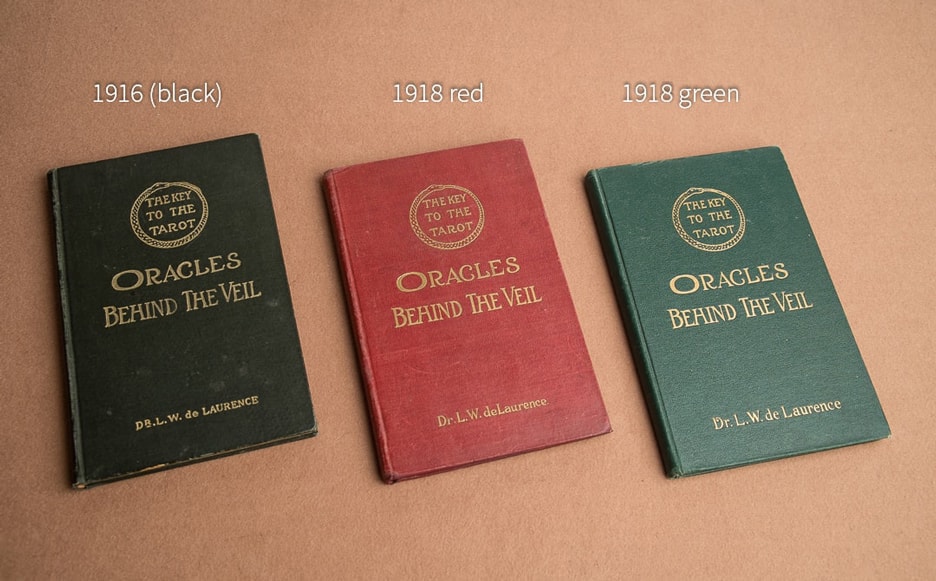
L.W. de Laurence’s “Key to the Tarot”
Over the summer of 1909 Arthur Edward Waite wrote The Key to the Tarot. The title idea came from a book he was translating earlier that year for William Rider & son, Ltd., who had bought out the Philip Wellby occult collection in 1908, launching Rider’s occult library of publications. That book was The Tarot of the Bohemians: the Most Ancient Book in the World. Waite prepared that book for publication and along with his previous research and induction into the Golden Dawn by MacGregor Mathers, he developed his idea for a “more metaphysically correct version” of the tarot. This would become England’s first tarot deck, as up until then the tarot was a continental game printed in Italy, France, Germany, and Spain; and used by some for fortune telling. Naturally his new deck would need an instruction manual (a “Little White Book” or LWB — even though the “LWB” ubiquitous to today’s tarot cards would not officially be created until 1960 by the visionaries at University Books, inc. in Manhattan).
Mathers had written a short book called The Tarot 21 years earlier from his own research. By the time that Waite was inducted into the Golden Dawn Mathers had ascended to the leadership, a position he was ill-suited for. The Golden Dawn was well past its prime, but was primed for a renaissance with the coming of Waite, Crowley, and a handful of new members whose only ties were their forthcoming membership and personal accomplishments. Mathers’ tyranny had caused the breakup of the original order, but he loved his power and position far too much to let this golden goose die, and so by the time that Waite created his public tarot, with the help of a talented young artist who was a junior member of the GD, Mathers had imbued Art (Waite) and Pam (Colman Smith) with his ideology–inasmuch as Mathers was capable of shaping the mind of a serious scholar of metaphysics who had years of researching and translating old manuscripts for the English speaking world.
The Key to the Tarot contains much of Mather’s ideas set down in his 1888 book, sometimes almost verbatim, and Mathers was the invisible hand that convinced Art to change the suit of Coins into “Pentacles” among other beliefs we take for granted to this day. In all fairness, the deck should be called the (Mathers)-Waite-Smith deck, but since history has already decided that it should be termed “Waite-Smith,” let’s not upset the apple cart of popular belief. In every way, Arthur Edward Waite deserves credit for his authorship of The Key to the Tarot, just as much as it was his idea to make a public deck (something Mathers was not keen on), and also as much as Pixie (Pam) influenced Art to allow her to illustrate the “pip suits,” having seen a photographic copy of the Sola Busca deck on display at the London Museum.
Enter L.W. de Laurence, stage left . . .
L.W. had previously prepared public domain works for the explosive growth market that was America’s love of the occult and Eastern mysticism. He considered some of Waite’s previous work public domain and published it, profited from it, and sold a lot of copies, so it is no stretch that when he came into contact with The Pictorial Key to the Tarot (almost certainly between late 1915 and early 1916) he saw the potential to exploit these new wonderful “fully illustrated cards” and the book from which the artwork was lifted. There is a slim possibility that de Laurence did in fact possess an “A deck,” but this flies in the face of everything that happened as a result of his exposure to Pam’s work. L.W. never published a deck in color, other than the yellow enhancements he added to his deck. Furthermore, the act of isolating the line art from an “A deck” (pre-colored) would be exponentially more expensive than simply using the camera ready art so conveniently provided in Waite’s PKtT, which was far easier to obtain. Also remember that L.W. was in the business of making books and other “exotic items” available to an underserved market (in his mind). He did not simply copy whatever someone else was already selling; his business model centered around high demand items that he considered hard to obtain otherwise. This was, after all, the key to his phenomenal success. Had the Rider decks been readily available in the U.S., no one would have ever bought the one published by de Laurence.
Please keep in mind that L.W. de Laurence only ever published one deck, what we now call the “square yellow” for convenience,” even though he lived another twenty years past its inception. His first ad for “his new deck” included Mathers’ book The Tarot, which he had available and ready for sale. His version of Art’s Pictorial Key to the Tarot would not be ready for sale until 1917. His cards were printed on heavy cardstock (not playing card stock), and were rectangles, devoid of the rounded edges his son Velo would add when he published the (now -termed) “round yellow de Laurence deck” in 1943 or 1944, seven or eight years after his father had passed on.
L.W.’s book and decks always included black line art (this would be Wm. Rider & Son, Ltd.’s printing of Pam’s final art for The Pictorial Key to the Tarot) and gray shading (de Laurence’s touch), and swaths of yellow to create his distinctive “five oriental colors” (black, half-screen black, or “gray,” yellow, half-screen yellow or “light yellow,” and the mix of the two half-screens to create ochre). It would only be after L.W.’s death that Velo would reduce printing costs and publish The De Laurence co.’s Key to the Tarot (Oracles Behind the Veil) on less expensive pulp paper, and with no yellow highlights. As this started in the Great Depression, it makes good business sense to cut expenses to keep from having to raise the price on scarce materials. Over the years The De Laurence co.’s Key to the Tarot was reprinted several times, with various covers (please see the gallery below), but the yellow highlights were reserved for the first three editions only. Download a (legal) PDF of the 1916 edition of this book here. This is a high-quality scan. I have already donated to Aisha to help the cause. If you can spare a dollar or two to help keep her site up please do.
Please click on the image to see it full-sized, or on the arrows to scroll through the various pictures.
It is really too bad this book is a blatant act of plagiarism. It is handsomely bound and printed on exquisite stock. This is most certainly an heirloom edition, despite the tumor on the ouroborous (snake) and the sloppy printing on the cover (not to worry, the 1918 edition was much cleaner). Sadly however, this is the only gilt-edge edition L.W. was ever to make, at least of this book. All outside edges are gilt (not just the top) and after 98 years the spine and binding are strong and tight. The copy shown here has seen wear and use, but it has laughed off a century of abuse and will probably last another (I will be dust and bones by then).
Damn you de Laurence for outliving me! To the last, I grapple with thee; From Hell’s heart, I stab at thee; For hate’s sake, I spit my last breath at thee.
Please click on the image to see it full-sized, or on the arrows to scroll through the various pictures.
This
Please click on the image to see it full-sized, or on the arrows to scroll through the various pictures.
This
Please click on the image to see it full-sized, or on the arrows to scroll through the various pictures.
This




